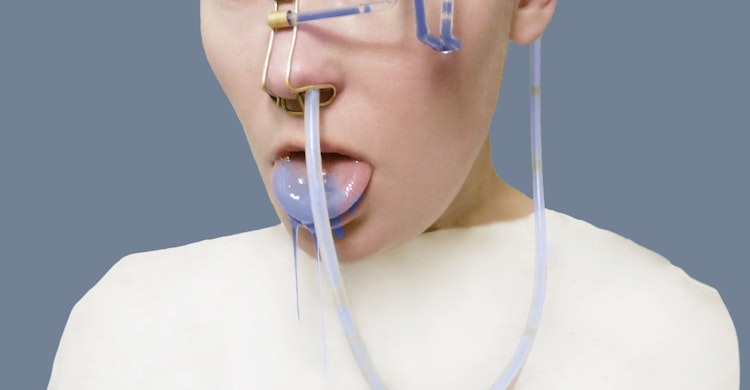

courtesy of the artists
In an interview with three artists, Johanna Zanon explores the theme of the relationship between the body and metal art and jewellery. Renate D. Dahl's work focuses on questioning the social norms and standards associated with the female form. Judit Fritz works at the intersection of crafts and sciences, experimenting with using sweat and tears to grow gemstones. Finally, Lauren Kalman uses craft-based materials in her performance-based videos, photographing and distorting the body in sometimes grotesque and violent ways, in order to explore attraction and repulsion.
An artist drives her car from the small town of Horten to her studio in Oslo with four casts of her stomach, back, and buttocks at different BMIs1 as passengers, belts on and music blasting. ‘Me, myself, and I – literally,’ laughs the artist. Meanwhile another artist sets up a clandestine gym in Stockholm to collect as much sweat as she can from the labouring bodies of her donors. She muses: ‘It is interesting how we tie in emotions with our sweat, even though it becomes purely an object through the crystallisation process.’ Before that, a third artist spent hours in her Detroit studio drooling on devices that warped her face, while her arms exhausted themselves holding the camera out. ‘It would have been unethical,’ she comments, ‘to ask somebody else to pose in such discomfort for so long.’
The artists are, in order of appearance: Renate D. Dahl, Judit Fritz, and Lauren Kalman.2 They have never met, but their work engages in a conversation about the relationship between the body, on the one hand, and jewellery and metal art, on the other. Where Modernity favoured depth over the superficial, and where Postmodernity had flipped this hierarchy on its head, Dahl, Fritz, and Kalman are representative of a new paradigm – sometimes referred to as Post-postmodernism or Metamodernism – which blurs the boundaries between depth and surface. All three artists turn the body inside out and question its limits. Put differently, they access the innermost corner of the outermost layer.
Three practices in a nutshell
The work of Renate D. Dahl caught my eyes at her BFA graduation show in Oslo, when I walked into a small room with pink walls and pink carpet, showcasing giant hoops, silicon moulds of her breasts, and photos of herself when she made the moulds. Borrowing from the Kardashians, and wittily referring to unrealistic body expectations, she titled the installation The Bigger the Hoops, the Bigger the Hoe. Since then, Dahl has graduated with an MFA in Metal Art and Jewellery from the Oslo National Academy of the Arts and has developed several series on the topic. I wanted to ask her how she would define her incredibly versatile practice, which encompasses a multitude of materials, from bronze, to chocolate, and margarine:
Renate D. Dahl (RDD): ‘I work on the female body and the “overweight” body. I look at how one fits or doesn’t fit into society, the social norms associated with bodies. I have the urge to make something from a lived experience in my own body. I am most interested in normal day-to-day things,like sitting in a crowded bus and worrying about taking too much space. Now it’s ok for me, but when I was bigger, I was really afraid of going over the seat line, of taking somebody else’s space because my body wouldn’t fit into the standards.’
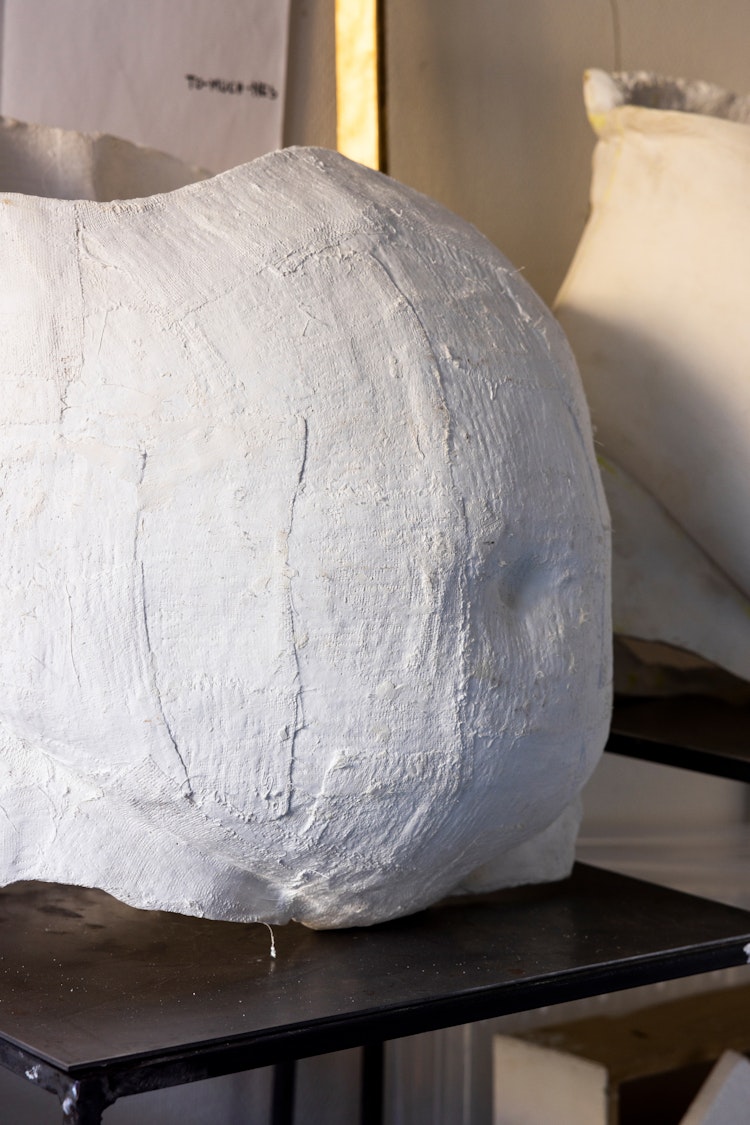
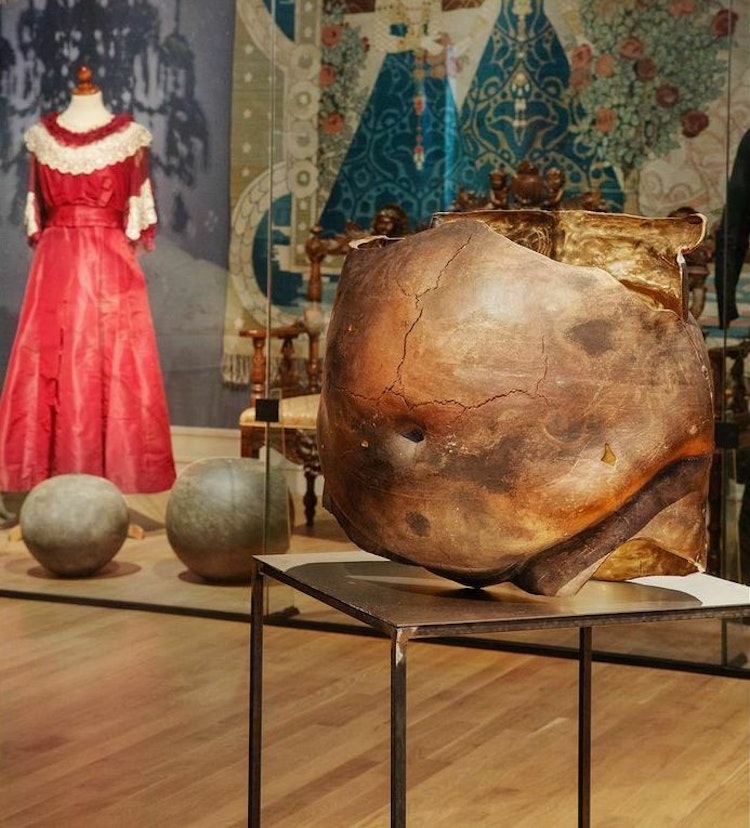
Judit Fritz is an artist in her final year of her master’s in Jewellery and Corpus at Konstfack in Stockholm, who works at the intersection of crafts and science. When I scrolled down her Instagram account, I immediately got interested in the gemstones she grows from human sweat and tears, and the facial masks that seem like cruel contraptions designed to extract tears. Here is how she defines her practice:
Judit Fritz (JF): ‘The core of my practice is working with metal as a material and a technique. My interest in science and geology has broadened my practice to question what metal is and where it is to be found. For instance, I look at the periodic table and the many forms that metal takes. I use methods from the science field to perform experiments, but I do not have to reach a fact-based conclusion. I propose aesthetic, poetic, and material responses to scientific questions. In that sense, I am doing artistic research.
For my MFA project, I crystallise body minerals together with nanometals and oxides, which gives them a variety of colours. From there, I go into the subject of how minerals enter and exit the human body. I build a body of work that contextualises what I think is the poetry of being a complex machine made of flesh.’
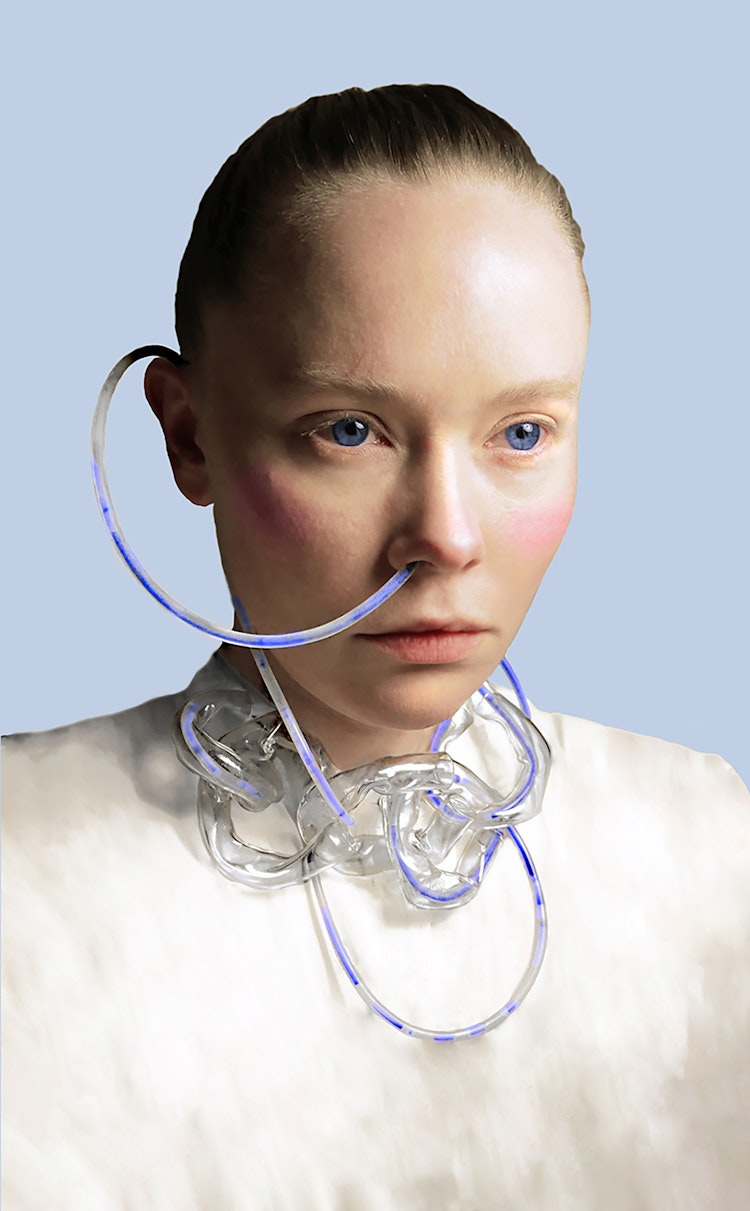
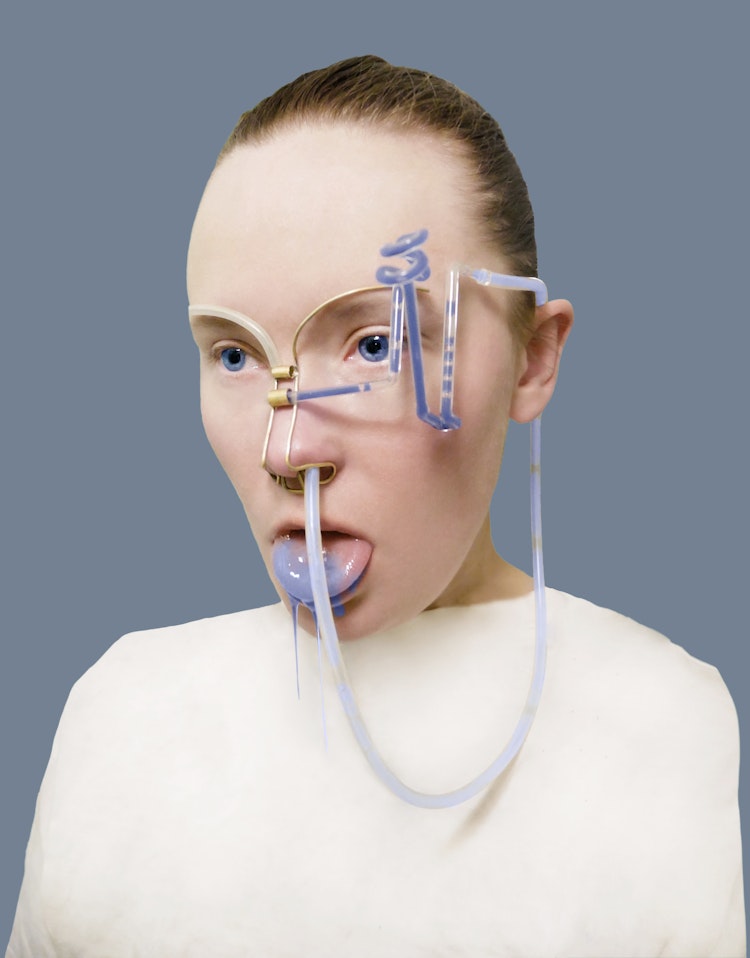
I encountered the work of Lauren Kalman several years prior on Google Arts & Culture, of all places. The online exhibition Body of Work featured her series Devices for Filling a Void that distorts the body in sometimes grotesque and violent ways, dealing with attraction and repulsion. Her work made such a strong impression on me that I could not resist the opportunity to interview her. Kalman is an established artist based in Detroit, whose practice continues to revolve around the body:
Lauren Kalman (LK): ‘I make objects in craft-based materials like metals, ceramics, and glass that I use in performances for video and photography. And I do that because of their proximity to the body in everyday life. So they are familiar on a tactile level. People know the feeling of a metal spoon on the tongue. They understand its coolness and metallic taste. These materials have a democratic appeal too because they are pretty, I think. The combination of familiarity and attractiveness allows the initial response of the work to be an embodied experience. People feel it, they’re pleased by it or repulsed by it, but it’s a gut response. If they start to peel back strata of information, maybe they understand the narrative, connect it to their lived experience, and understand the theoretical nuances. It becomes a layered experience.’
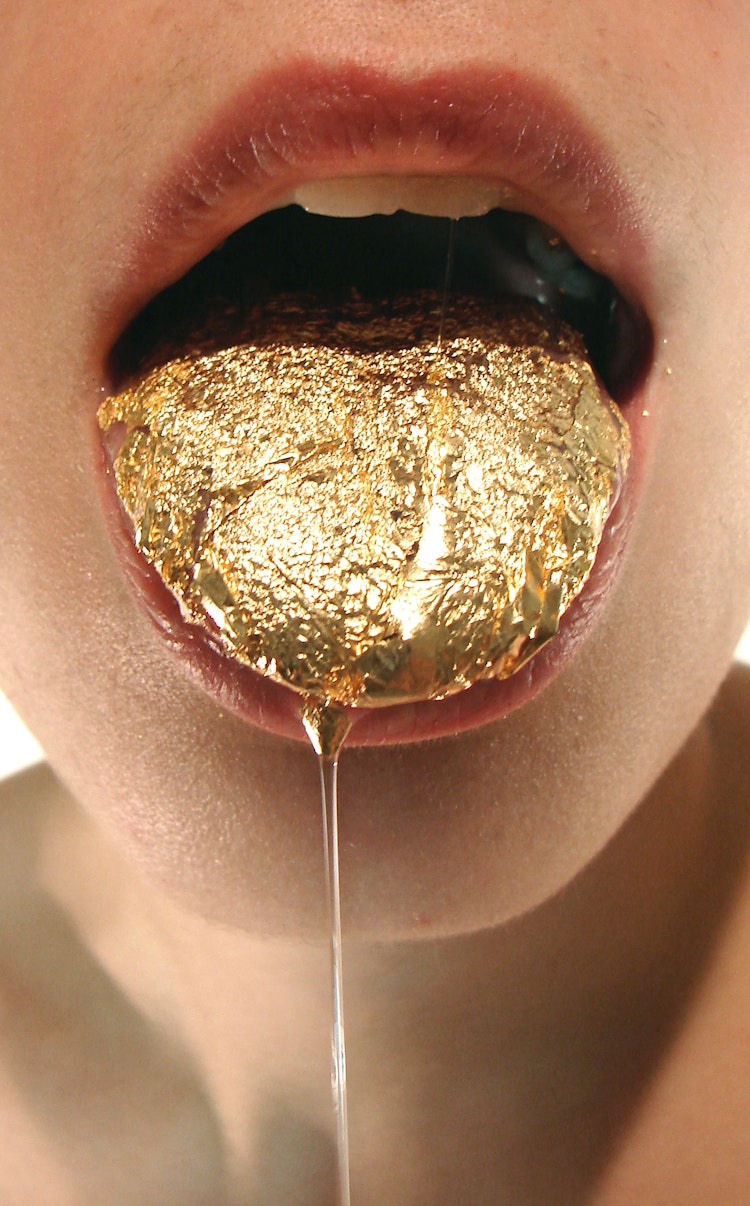
Bodily shame, salt, and endurance
Given that Dahl, Fritz, and Kalman share a common interest in the body, I wondered what spurred their exploration of the human body both as the subject and medium of their artistic practice:
RDD: ‘I didn’t realise at the beginning why I was doing what I did, but it’s so important for me not to have the shame that I used to have, and still have, about not fitting in. In 2019, I had a gastric sleeve operation to lose weight. That’s when it occurred to me how problematic my relationship to my body had been. When I was at my lowest, I thought I had to save money to do more surgery. I had this whole list with modifications ranked by priority. Should I lift my boobs? Here I have extra skin on my stomach, should I do something about it? You can always find something else you don’t like about yourself. That was how I started working with the body, but I didn’t get the connection until later on.
My work is also motivated by what I find unfair, even though I don’t think of myself as a political person. I saw how many others were ashamed to get help. So I wanted to talk about getting the operation based on my own experience. I have thought about working with other people and other bodies, but I don’t want to project my feelings onto somebody else and put words in their mouths. Maybe their feelings are not the same as mine. And I can never access the lived experience of others. It is necessarily mediated through what they say to me.
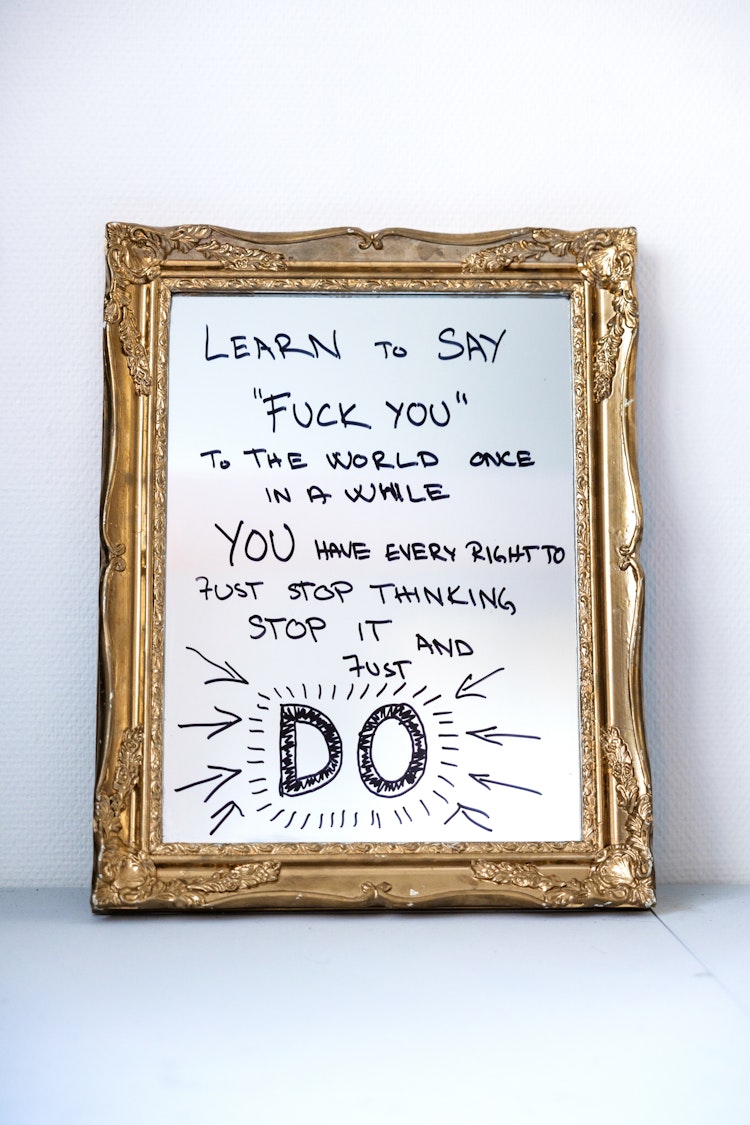
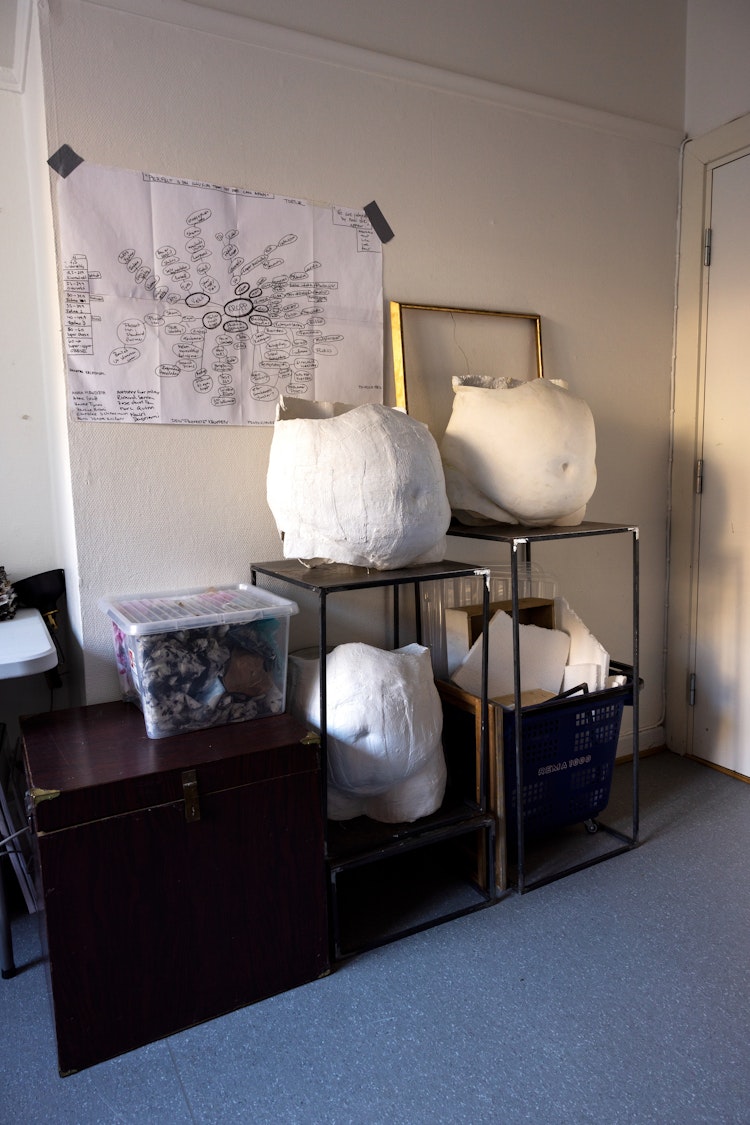
JF: ‘It was a coincidence that I came to work on the minerals in the body. When I was taking my BFA [at Konstfack], I did a project on water that saw the ocean as a transportation system. I became interested in how minerals travel and can be found in the human body. How did they end up there? How do they come out again? Like salt, for example. We often think of blood as a vital and a driving force, but almost all bodily fluids contain the same amount of salt. To me that raises the question: why do we carry salt? Is our purpose on earth to filter salt so that it circulates through human and non-human bodies? Why are we here? Minerals are vital not only for our bodies, but also outside of our bodies, for other organisms and systems. In a sense, they tie us together. I have stuck to salt and the many different shapes salt takes. Salt is not a valued substance nowadays, whereas it used to be a form of currency. It is connected to so many different systems – historical, cultural, and emotional.
Although visually similar, crystals made from tears and sweat chemically differ from regular salt as they contain other minerals from the human body. It’s interesting how we tie in emotions with the tears and sweat that eventually, through the crystallisation process, become something solid. When do they become an object? When are they not human anymore? I re-crystallised gems over and over again. Do they remain human, or are they something else entirely? Personally, I never really lose sight of their human side, since I know their origin, but for someone else, they would just be little pieces of salt, nothing more.’
LK: ‘Early on, I wondered why jewellery was photographed on young beautiful women. I wasn’t aware of feminist theory and the concept of the “male gaze” back then, but something didn’t quite feel right about that. I started doing performative gestures, like gold-leafing my tongue. I worked on my own body for convenience. I was holding the camera out, selfie-style, for hours and hours. It would have been unethical to ask somebody else to pose in such discomfort for so long. My work pulls from the lineage of artists doing durational and endurance-based performances, dealing with self-exploration. Whether I wanted it or not, the social identifiers became part of the work. It’s also why I can’t speak to another body’s experience. Since my initial performative work twenty years ago, my body has changed. And in another ten years it will have changed further away from the ideal body that is shown in advertisements and promoted on social media. If I keep using my body, I can talk about my ageing body.’
A desk worker, a lab rat, and a studio creature
Although the artists meet on many levels when it comes to the materials, techniques, and topics they explore, their work process differs greatly:
RDD: ‘My process is more idea-based than material-based. I often get an idea, and think about it for a long time. I go into all these rabbit holes before figuring out where I want to go. A rabbit hole can be anything from philosophy to investigating the body through time periods and cultures. I scribble a lot, and I often get back to what I have written to find inspiration. When I start making the objects, they are almost finished in my head. Of course, things can happen during the process, but I don’t need to be in the workshop all the time.
I also get ideas when I’m in a store finding a material, and I’m like: “Shit! I have to make something out of this.” Often I buy the materials and they lay there for maybe a year or two, and then I suddenly think: “This material could be perfect for this piece, let’s see if it works.” I choose materials based on the concept of the piece. I cast my dream body in chocolate in BMI 22.1, because it’s what I kept eating, and what kept me from getting the body that I wanted. Chocolate is also cheap and will spoil, so it hints at the paradoxical feeling of want and shame. It is the most desired body, yet it is the one that will last the shortest time. My craft has a concept, and my concept has a craft.
During the process, I usually let things rest for a while. I made pink casts of sugarcanes, but I am hiding them. I am not ready to show them yet. And that was the thing when I made the first cast of my body, when I was at my biggest. I put the cast on the shelf in my studio. It was taunting me to have to look at myself like that. It took maybe half a year before I could use it!’

JF: ‘I have an interdisciplinary way of thinking. I want to render visible the benefits of collaborating with other disciplines such as geology and natural sciences. There is a great difference between science and art, yet they can contribute to each other. They share the same tools but not the same rules – I just realised it rhymes! The deeper I delve in the field of science, the more I grow as a craft artist. And I find a lot of energy and inspiration in the conversations I have with several scientists whom a teacher introduced me to when attending different science courses a few years back. I need to take my notebook to those meetings! As soon as we start to chat, they immediately reach out for their own notebooks too. It is a two-way conversation.
My process involves a lot of research. I read different types of literature, including peer-reviewed articles, but also old alchemical treatises – texts written when people did not have the scientific knowledge we have today. I genuinely enjoy their insatiable curiosity. It is fascinating how many different angles they could take on a material, trying to understand what it really is, and connecting it to various animals and emotions. I find almost anything interesting if I can go deep enough. I then allow myself to write freely and speculatively, while incorporating connections of what I have read.
Most of the practical work is carried out in the workshops at Konstfack. I tend to work with materials and techniques that I have never worked with before. That’s when the most amazing things happen, because nothing interesting slips away due to pre-existing knowledge.’
LK: ‘I have a series of ideas I am interested in, such as the relationship between the body and the built environment (like jewellery, furniture, objects), but also constructions of femininity. I am interested in places, interstices, and gaps where I can call ideals into question, where the body is impolite, inappropriate even.
I read a lot of craft and performance theory. Recently I read The New Politics of the Handmade,3 Elissa Auther’s String, Felt, Thread,4 and Jenni Sorkin’s Live Form: Women, Ceramics, and Community.5 I have a particular interest in craft connections to the body, and how it has been used to marginalise bodies. But I don’t come up with an idea and then execute it. I’m very much a process-based artist. I go to the studio, get materials, and try things out. That process comes out of experience. I like materials that demand attention and craftsmanship. I find learning challenges attractive and satisfying.
I apply my interests in theory and art historical analysis after the fact. But of course, my interest in theory is in the background when I am making in the studio. At this point, it moves fluidly between ideation, production, and analysis.’

Sealing sugarcanes, crystallising minerals, and hugging vessels
Hoping to get a glimpse of how the artists will develop their practice further, I asked them about their current experimentations. While Dahl and Kalman presently experiment with new materials, Fritz refines the transformation of human fluids into jewellery:
RDD: ‘During my time in art school, I made new stuff all the time. Now, instead of running forward, I look back. I explore ways of working with the pieces I made, including through new materials. For example, I have been trying to make my own bioplastic from sugarcanes. My mom is working in the Dominican Republic with Haitian refugees. Some of them used to work in the sugarcane plantations. She brought some sugarcanes back, and I am experimenting with them. [She shows them to me.] These are dried now, so they are light, but they used to be heavier. I sealed them to see if they could keep the humidity, but it didn’t work!
I have been reading about how the West exploited sugar workers, including in Haiti, and how the consumption of sugar has affected our bodies. I am trying to see if I can connect the history of sugar with my own experience, without misappropriating Caribbean culture – as the sugar we consume today in Norway doesn’t come from sugarcane plantations, but from beet fields in Denmark.’6
JF: ‘I work with the idea of bodies constantly leaking and absorbing through the crystallisation of body fluids into gems. The more I work with those fluids, the less difficult it becomes. I don’t notice the smell of sweat anymore. But I don’t have a shield protecting me from how gross it is, especially in such quantity.’
JZ: ‘One teardrop does not equal one artwork?’
JF: ‘Not at all, I need much more than a drop to grow a gem! There are only tiny traces of minerals in sweat and tears. I started with my own tears and quickly learnt how much material I would need to make something visible.’
JZ: ‘You’re basically dealing with buckets of tears and sweat?’
JF: ‘I am … And it sometimes gives a strange feeling to work with body materials. It’s hard for me to separate the work from the people who donated fluids. I know what they did to produce the materials I am using. Once, I secretly built up a gym during a night and had people work out for me. I have images of that night! Someday, I will make a work about the making of the gems, but up until now I have been secretive. One reason is that I don’t want the viewer to be too influenced by it. I prefer to leave the interpretation open. Another is that all the donors chose to be anonymous. I signed a contract with them stating exactly what I would do with the collected materials to bring them into the lab. As soon as something emanates from the human body, one needs to comply with a whole set of rules. The same rules do not apply to other materials. That is also strange. Why shouldn’t we apply the same care to natural and animal materials?’
LK: ‘I work on several bodies of work simultaneously. I recently developed a jewellery-based series called Flourish, which uses stamping dies from the archives of a costume jewellery manufacturer, the Jakob Bengel Foundation in Germany. I took these decorative flourishes and reconfigured them into snot bubbles, vomit, and drool – what the body does when in distress. They are featured in 1-second looped videos that capture the body in a twitch.
I am currently working on larger ceramics of about two feet tall [60 cm] that I throw. I keep the vessels wet, and hug them in a series of performance videos. Concurrently, I have been working on a series of glass objects as part of the Burke residency at the Corning Museum of Glass, which I also wanted to hug. While I had my whole body moulded in different positions at Indépendant Casting so that the two amazingly talented glassblowers I collaborated with – Darin Denison and Ross Delano – could blow bubbles on its surface and shape them in familiar forms (like a vase), with glass, and ceramic: Boom, it’s done! The distortion is immediate. It freezes a moment in time, almost like a photograph. It’s exciting for me!’
All photos courtesy of Lauren Kalman
Thinking with Deleuze & Guattari
Philosophers Gilles Deleuze and Félix Guattari theorise the “body-without-organs”,7 which refers to a body unlimited by its organs, operating freely without organisational structures imposed on its constituent parts. In my opinion, Dahl, Fritz, and Kalman extend the concept of body-without-organs.
Dahl’s work represents body-parts-without-organs freed from the functional imperatives of digestion. The fragmented shells of her body, albeit carrying residual violence, materialise learnt kindness in her journey towards self-acceptance. In that, the sections are more than the sum of their parts.
Fritz’s gems can be qualified as body-fluids-without-organs. She says: ‘I certainly question where our organs start and where they end. What is content? Does it have to be inside the body to be content?’ In her work, tears and sweat are no longer the products of discrete glands in the eyes and under the skin. What’s more, the hierarchy between fluids comes undone: who can tell the difference between a gemstone made from tears of joy or rancid sweat? But Fritz cautions us against the capacity of body-fluids-without-organs to reorganise the human body as a whole: ‘We can’t afford the luxury of excluding the idea of organs. That would free us from our responsibilities as living bodies, with dramatic consequences for the environment and other species.’
Body-voids-without-organs describes Kalman’s devices, ornaments, and vessels that fill the cavities and “voids” of her body. These negative forms both disregard and override the organs under the body surface, restructuring it from the outside in.
In total, the three artists suggest different types of body reconfiguration that have the potential to liberate the female body, as well as other bodies that have been misrepresented, alienated, disregarded, or mistreated




